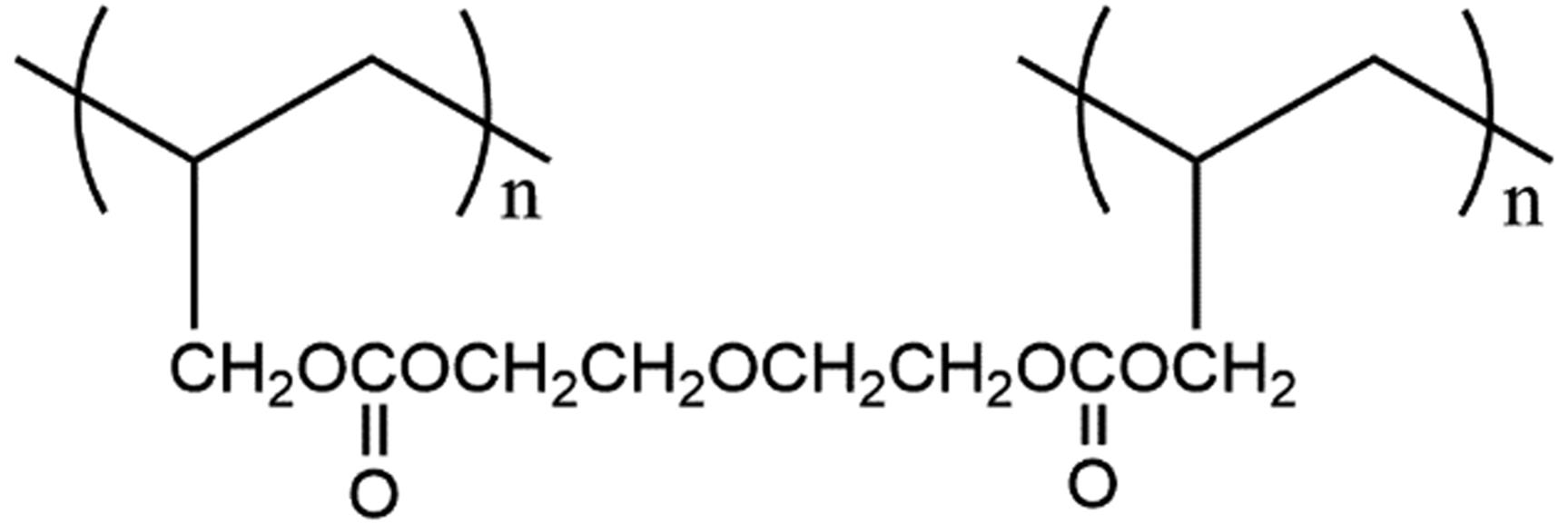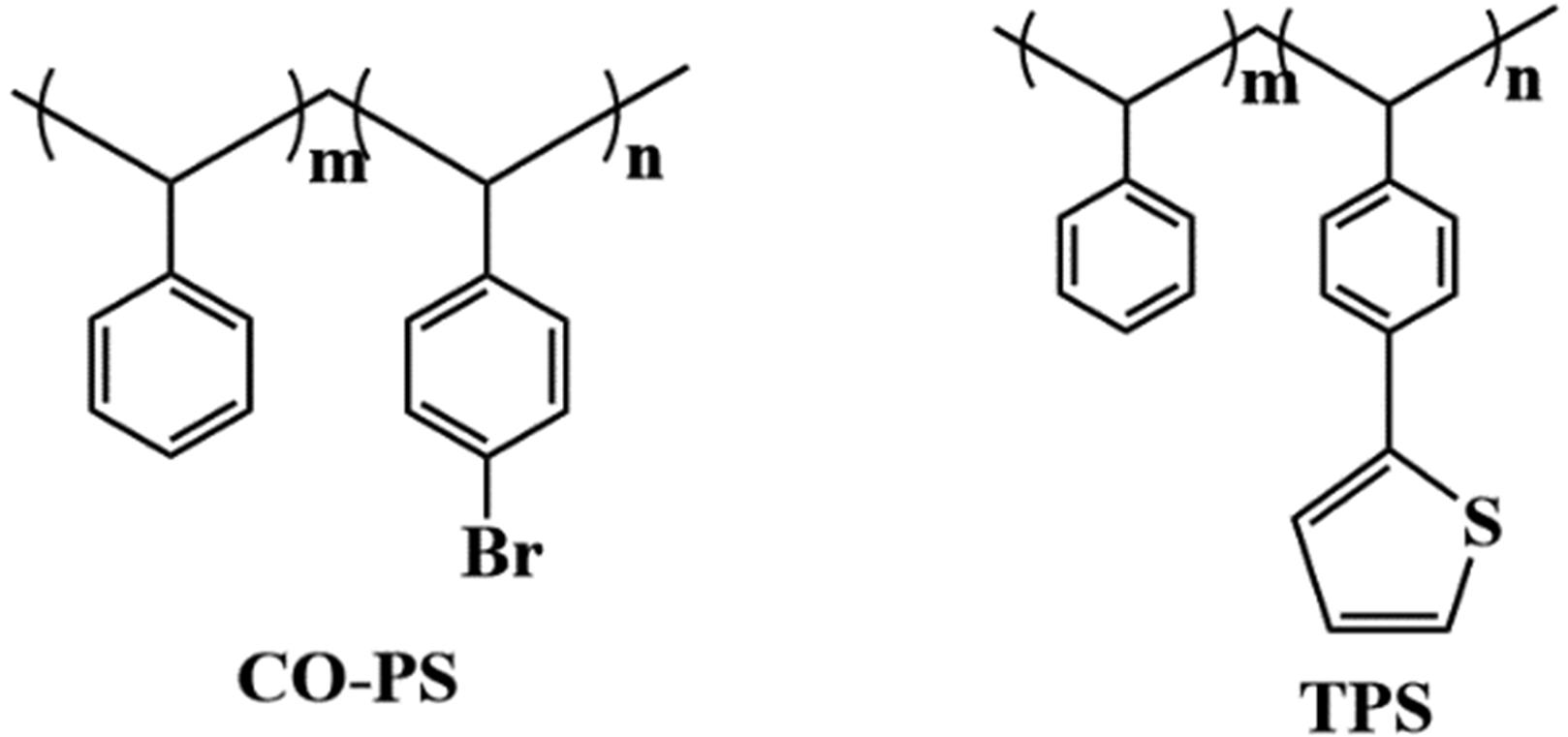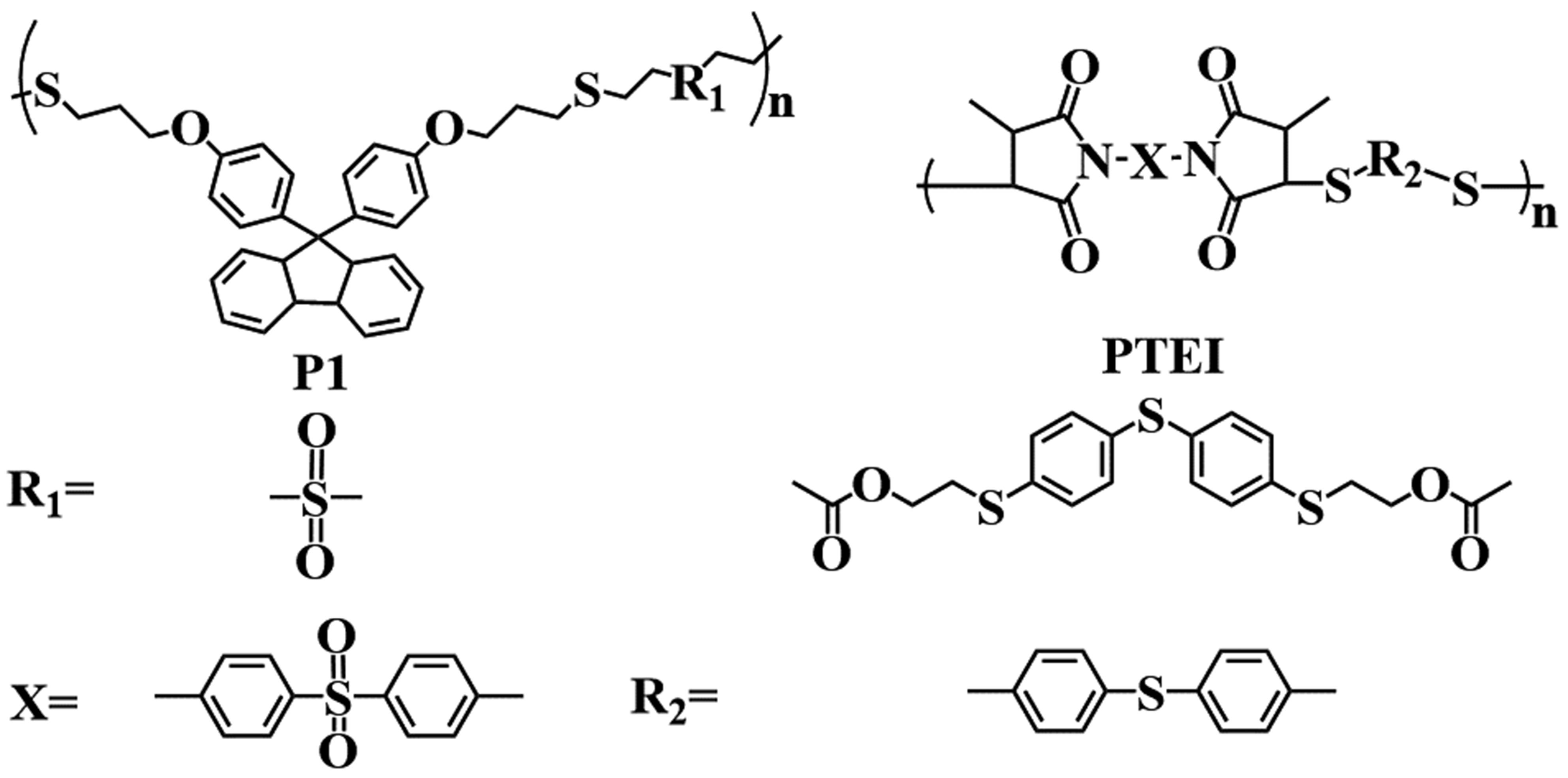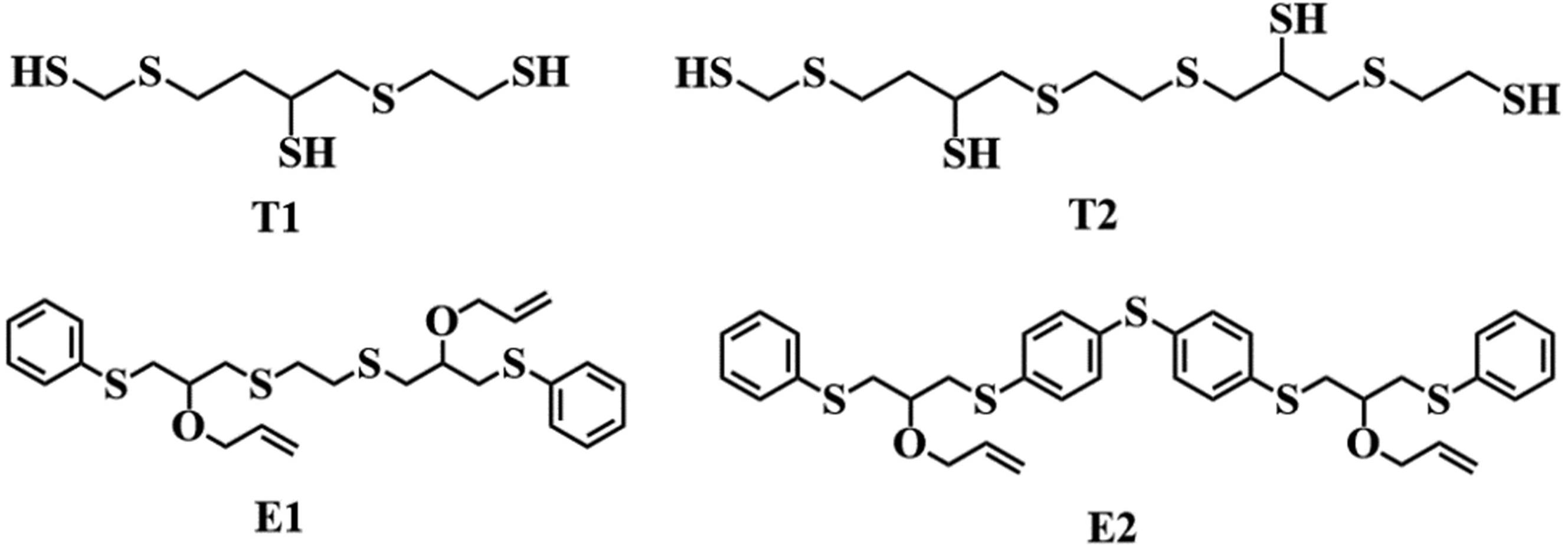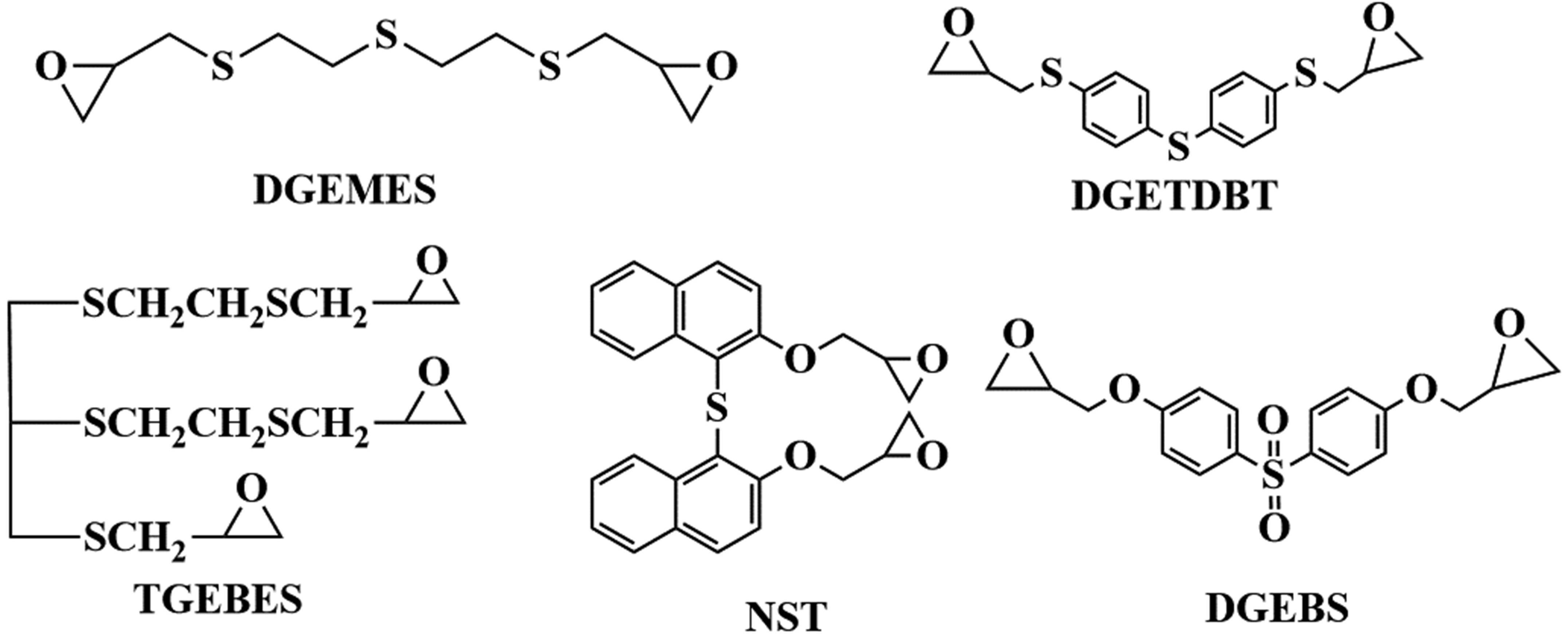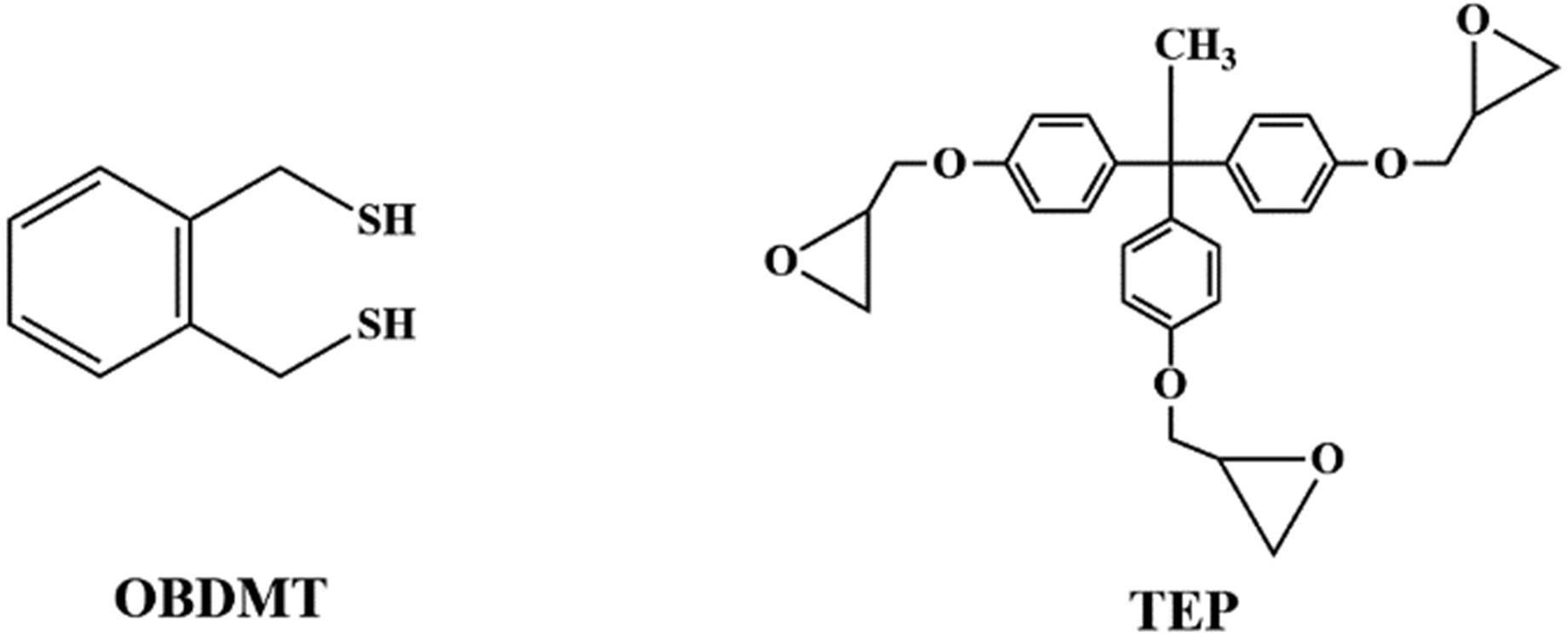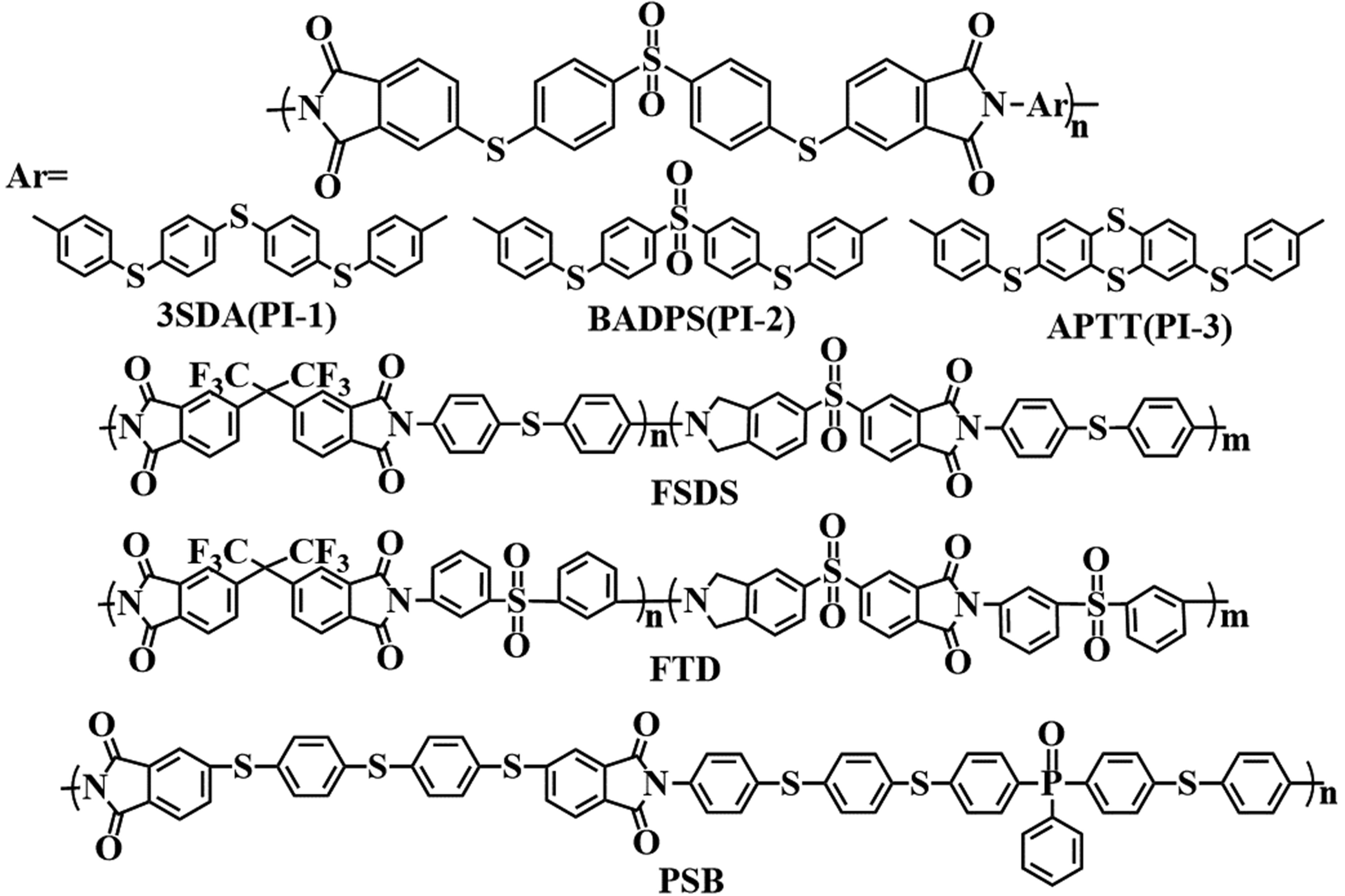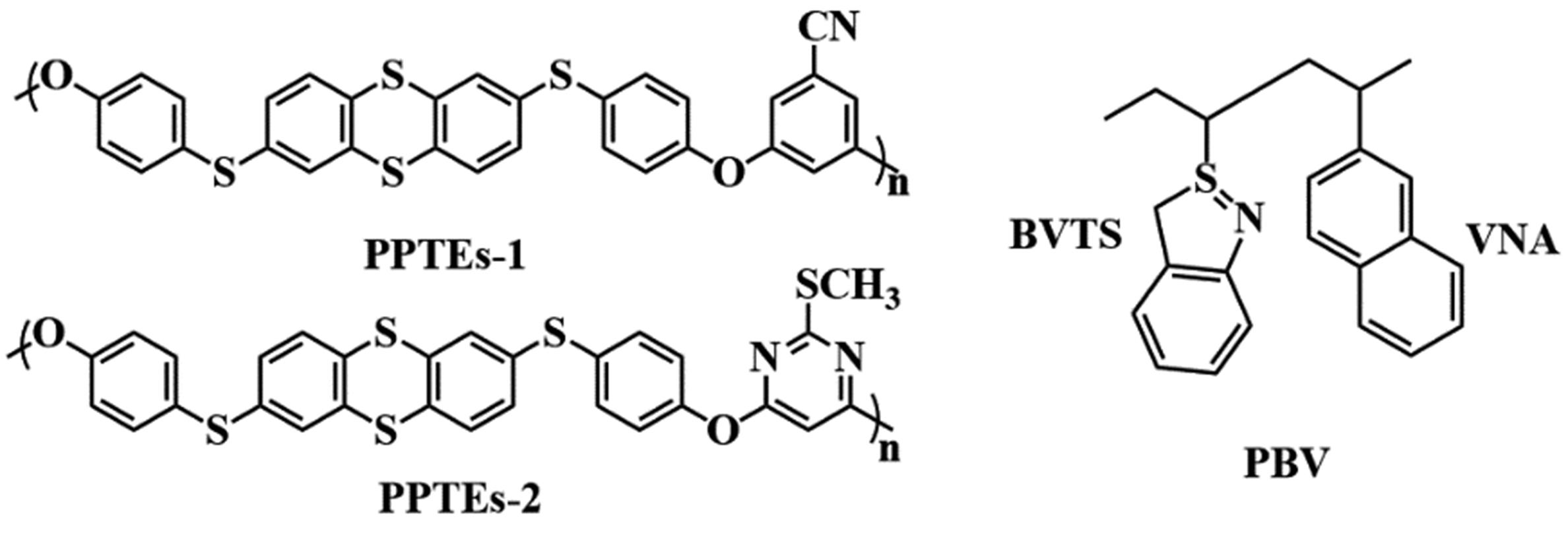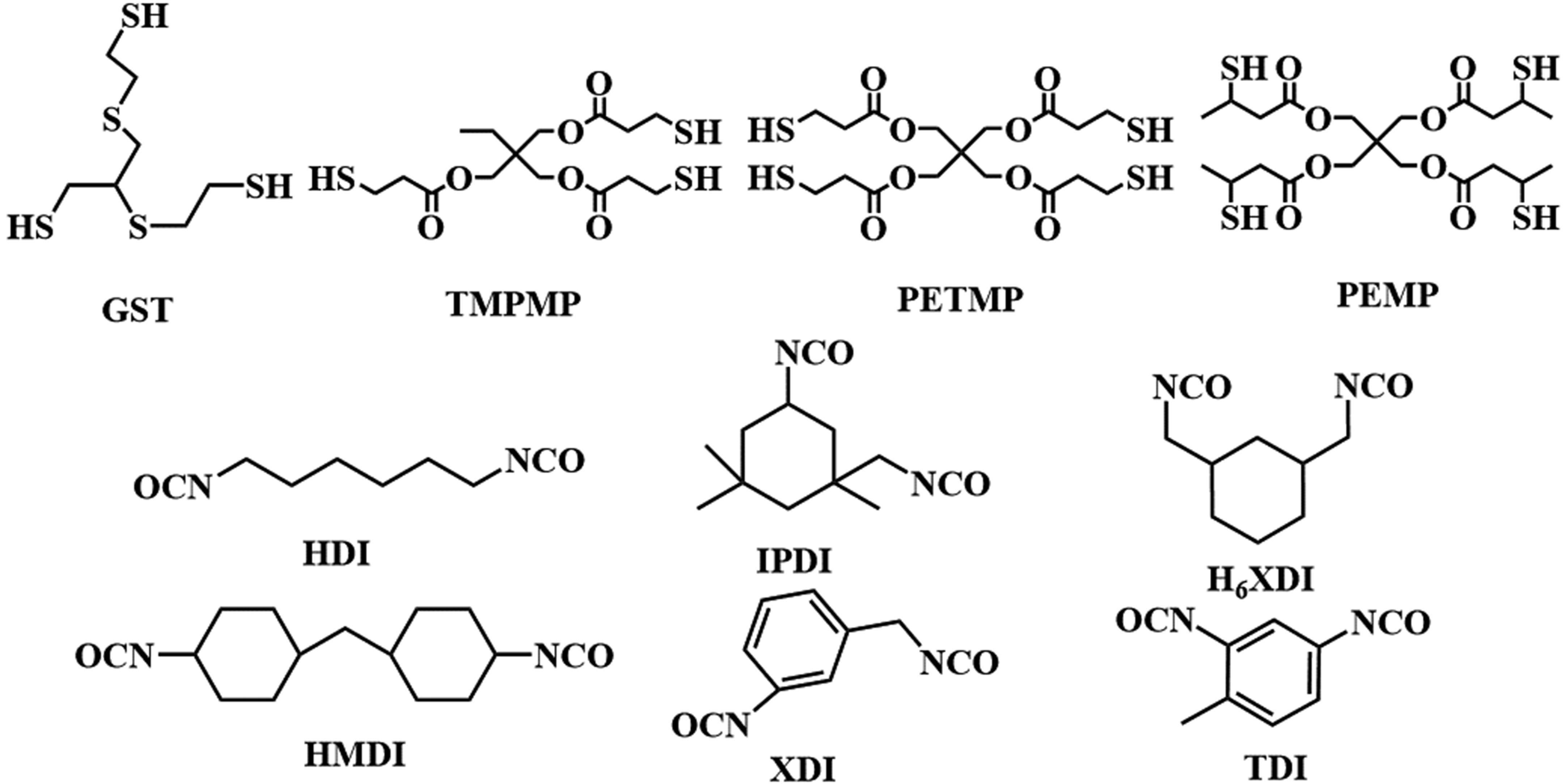
Chinese Journal of Applied Chemistry ›› 2022, Vol. 39 ›› Issue (5): 723-735.DOI: 10.19894/j.issn.1000-0518.210136
• Review • Previous Articles Next Articles
Research Progress on Synthesis and Properties of Sulfur⁃Containing High Refractive Index Optical Resins
Xiao-Feng GUO1,2, Jia-Lin LI2( ), Yu-Bo WANG1,2, Jun-Su JIN1(
), Yu-Bo WANG1,2, Jun-Su JIN1( )
)
- 1.College of Chemical Engineering,Beijing University of Chemical Technology,Beijing 100029,China
2.Bohua Chemical Technology Co. Ltd,Tancheng 276100,China
-
Received:2021-03-22Accepted:2021-07-07Published:2022-05-01Online:2022-05-24 -
Contact:Jia-Lin LI,Jun-Su JIN -
About author:jinjs@mail.buct.edu
abcljl@163.com.cn
-
Supported by:the National Natural Science Foundation of China(21878017)
CLC Number:
Cite this article
Xiao-Feng GUO, Jia-Lin LI, Yu-Bo WANG, Jun-Su JIN. Research Progress on Synthesis and Properties of Sulfur⁃Containing High Refractive Index Optical Resins[J]. Chinese Journal of Applied Chemistry, 2022, 39(5): 723-735.
share this article
Add to citation manager EndNote|Ris|BibTeX
URL: http://yyhx.ciac.jl.cn/EN/10.19894/j.issn.1000-0518.210136
原子/基团 Atoms/groups | 摩尔折射率 Molar refractive index/(cm3?mol-1) | 原子/基团 Atoms/groups | 摩尔折射率 Molar refractive index/(cm3?mol-1) |
|---|---|---|---|
| H | 1.100 | F | 0.898 |
| C | 2.418 | Cl | 5.967 |
| —CH3 | 5.644 | Br | 8.865 |
| —CO—NH- | 7.230 | I | 13.900 |
| —S— | 7.920 | —SH | 7.690 |
| —S—S— | 8.110 | —SO2— | 9.630 |
 | 25.463 |  | 43.000 |
Table 1 Molar refractive index of some atoms or groups[1]
原子/基团 Atoms/groups | 摩尔折射率 Molar refractive index/(cm3?mol-1) | 原子/基团 Atoms/groups | 摩尔折射率 Molar refractive index/(cm3?mol-1) |
|---|---|---|---|
| H | 1.100 | F | 0.898 |
| C | 2.418 | Cl | 5.967 |
| —CH3 | 5.644 | Br | 8.865 |
| —CO—NH- | 7.230 | I | 13.900 |
| —S— | 7.920 | —SH | 7.690 |
| —S—S— | 8.110 | —SO2— | 9.630 |
 | 25.463 |  | 43.000 |
| 1 | 杨柏, 吕长利, 沈家骢. 高性能聚合物光学材料[M]. 北京: 化学工业出版社, 2005: 34-35. |
| YANG B, LÜ C L, SHEN J C. High performance polymer optical materials[M]. Beijing: Chemical Industry Press, 2005: 34-35. | |
| 2 | 高长有. 含硫高折光指数光学塑料的分子设计[J]. 材料研究学报, 1999, 13(1): 9-16. |
| GAO C Y. Molecular design of high refractive index optical plastics containing sulfur[J]. Chin J Mater Res, 1999, 13(1): 9-16. | |
| 3 | CHENG Z, MENG H X, LU R, et al. Sulfur-containing polymers from terpolymerization of active methylene compounds, carbon disulfide, and dihalohydrocarbons: synthesis and properties[J]. Polym Chem, 2019, 10: 5333-5338. |
| 4 | KAYANOKI H, ISHIZUKA S, TAKIGAWA A. Resin composition having high refractive index properties: EP, 0524477[P]. 1993-04-14. |
| 5 | YOSHINARI K, KAZAMA H, MATSUOKA S. Phosphoric ester compound and production thereof: JP, 04300886[P]. 1992-10-23. |
| 6 | KOBAYASHI S, SASAGAWA K, KANEMURA Y, et al. New sulfur-containing aromatic acrylate: JP, 04077467[P]. 1992-03-11. |
| 7 | AN Y C, KONISHI G I. Facile synthesis of high refractive index thiophene-containing polystyrenes[J]. J Appl Polym Sci, 2012, 124(1): 789-795. |
| 8 | MAHESWARA M, OH S H, JU J J, et al. High refractive index of transparent acrylate polymers functionalized with alkyl sulfur groups[J]. Polym J, 2010, 42(3): 249-255. |
| 9 | 唐云辉. 高折射率光学树脂的分子设计、合成及应用研究[D]. 北京: 北京化工大学, 2019. |
| TANG Y H. Molecular design, synthesis and application of high refractive index optical resin[D]. Beijing: Beijing University of Chemical Technology, 2019. | |
| 10 | YOU N H, HIGASHIHARA T, ANDO S, et al. Highly refractive polymer resin derived from sulfur-containing aromatic acrylate[J]. J Polym Sci Part A: Polym Chem, 2010, 48(12): 2604-2609. |
| 11 | NAKABAYASHI K, SOBU S, KOSUGE Y, et al. Synthesis and nanoimprinting of high refractive index and highly transparent polythioethers based on thiol-ene click chemistry[J]. Polym Chem, 2018, 56: 2175-2182. |
| 12 | ZUO J D, LIU Z, LUO C Y, et al. Preparation and properties of high refractive index polythioetherimide film based on thiol-ene click chemistry[J]. Prog Org Coat, 2021, 151: 106048. |
| 13 | ALIM M D, MAVILA S, MILLER D B, et al. Realizing high refractive index thiol-X materials: a general and scalable synthetic approach[J]. ACS Mater Lett, 2019, 1(5): 582-588. |
| 14 | AOYAGI N, ENDO T. Synthesis of aliphatic polymers with high refractive index by photoinduced polyaddition of thiols to bifunctional allyl monomer containing tetrathiaspiro structure[J]. Polym Chem, 2019, 57(11): 1160-1164. |
| 15 | WEI Q, PÖTZSCH R, KOMBER H, et al. High refractive index hyperbranched polymers with different naphthalene contents prepared through thiol-yne click reaction using disubstituted asymmetric bulky alkynes[J]. Polymer, 2014, 55(22): 5600-5607. |
| 16 | 吴建兵. 含巯基光固化材料的制备及其在紫外光固化涂料中的性能研究[D]. 太原: 太原理工大学, 2015. |
| WU J B. Preparation and properties of UV curable materials containing mercapto groups[D]. Taiyuan: Taiyuan University of Technology, 2015. | |
| 17 | ZHOU S Q, MAO Y J, ZHOU Z F, et al. Preparation of 2,5-bis(methylallyl thioester)-thiadiazole with high refractive index and its coatings[J]. J Coat Technol Res, 2017, 14(6): 1457-1461. |
| 18 | 罗超云. LED用高折射率光学树脂的制备与性能研究[D]. 广州: 华南理工大学, 2013. |
| LUO C Y. Preparation and properties of optical resin with high refractive index for LED[D]. Guangzhou: South China University of Technology, 2013. | |
| 19 | 吕长利, 崔占臣, 杨柏. 高折射率环氧和环硫型光学树脂的研究进展[J]. 应用化学, 2001(5): 342-346. |
| LÜ C L, CUI Z C, YANG B. Developments of epoxy and episulfide-type optical resins with high refractive index[J]. Chinese J Appl Chem, 2001(5): 342-346. | |
| 20 | 吕长利, 崔占臣, 杨柏, 等. 新型复合环氧光学树脂的制备与性能研究[J]. 高等学校化学学报, 2001(11): 1924-1928. |
| LÜ C L, CUI Z C, YANG B, et al. Preparation and property study of novel composite epoxy-type optical resins[J]. Chem J Chinese Univ[J]. 2001(11): 1924-1928. | |
| 21 | 张道洪, 陈苏芳, 吴璧耀. 高折射率含硫环氧树脂的合成与表征[J]. 粘接, 2004(5): 1-4. |
| ZHANG D H, CHEN S F, WU B Y. The synthesis and characterization of high refractive index sulfur-containing epoxy resin[J]. Adhesion, 2004(5): 1-4. | |
| 22 | 欧阳胜明. 一种光学含硫环氧树脂镜片材料的制备方法: 中国, 109232860A[P]. 2019-01-18. |
| OUYANG S M. Preparation method of optical epoxy resin lens material containing sulfur: CN, 109232860A[P]. 2019-01-18. | |
| 23 | 陈旭旺. 提高LED封装用环氧树脂折射率的研究[D]. 南京: 南京理工大学, 2016. |
| CHEN X W. Study on improving the refractive index of epoxy resin for LED packaging[D]. Nanjing: Nanjing University of Science & Technology, 2016. | |
| 24 | 郑永华, 王明华, 郑莹, 等. 一种含硫环氧树脂单体、光学树脂材料及其制备方法: 中国, 106279289B[P]. 2019-05-24. |
| ZHENG Y H, WANG M H, ZHENG Y, et al. A novel sulphur-containing epoxy resin monomer and optical resin material and its preparation method: CN, 106279289B[P]. 2019-05-24. | |
| 25 | STRZELEC K, BĄCZEK N, OSTROWSKA S, et al. Synthesis and characterization of novel polythiourethane hardeners for epoxy resins[J]. C R Chimie, 2012, 15(11/12): 1065-1071. |
| 26 | FLORES M, TOMUTA A M, FERNÁNDEZ-FRANCOS X, et al. A new two-stage curing system: thiol-ene/epoxy homopolymerization using an allyl terminated hyperbranched polyester as reactive modifier[J]. Polymer, 2013, 54(21): 5473-5481. |
| 27 | 杜曾. 含硫高折射率树脂的合成及其固化产物的性能研究[D]. 青岛: 青岛科技大学, 2013. |
| DU Z. Study on synthesis and properties of sulfur-containing resin with high refractive index[D]. Qingdao: Qingdao University of Science & Technology, 2013. | |
| 28 | BARI G, KIM H. High-refractive-index and high-barrier-capable epoxy-phenoxy-based barrier film for organic electronics[J]. Polym Adv Technol, 2020, 31(8): 1752-1764. |
| 29 | 李亚锋. 环硫树脂的合成及应用研究[D]. 北京: 北京化工大学, 2006. |
| LI Y F. Study on the synthesis and application of thiiran resins[D]. Beijing: Beijing University of Chemical Technology, 2006. | |
| 30 | 尚子扬. 双酚F环硫/环氧树脂的合成及固化行为研究[D]. 北京: 北京化工大学, 2014. |
| SHANG Z Y. The synthesis and curing behavior of bisphenol-F thiirane/epoxy resin system[D]. Beijing: Beijing University of Chemical Technology, 2014. | |
| 31 | TANG Y, CARLOS P H, NIU Q, et al. A novel high-refractive index episulfide-thiol polymer for nanoimprinting optical elements[J]. J Mater Chem C, 2018, 6(32):8823-8831. |
| 32 | 潘敏. 高折射率含硫树脂关键单体的设计、合成及性能研究[D]. 武汉: 华中科技大学, 2012. |
| PAN M. A thesis submitted in fulfillment of the requirements for the degree of master of science[D]. Wuhan: Huazhong University of Science & Technology, 2012. | |
| 33 | YUE T J, ZHANG M C, GU G G, et al. Precise synthesis of poly(thioester)s with diverse structures by copolymerization of cyclic thioanhydrides and episulfides mediated by organic ammonium salts[J]. Angew Chem Int Ed, 2019, 58(2): 618-623. |
| 34 | 郭清兵, 龚柳青, 吴俊凯, 等. 高折射率环硫树脂镜片材料的制备与性能研究[J]. 仲恺农业工程学院学报, 2014, 27(4): 7-10. |
| GUO Q B, GONG L Q, WU J K, et al. Preparation and performance study of high refractive index episulfide resin using as optical lens[J]. J Zhongkai Univ Agric Eng, 2014, 27(4): 7-10. | |
| 35 | 何臻, 赵亚丽, 庄韦, 等. 环氧-环硫树脂/凹凸棒土复合体系性能[J]. 塑料, 2014, 43(5): 67-70, 116. |
| HE Z, ZHAO Y L, ZHUANG W, et al. Properties of epoxy-episulfide resin/attapulgite composite[J]. Plastics, 2014, 43(5): 67-70, 116. | |
| 36 | 钱军, 戴双汉. 一种高折光率镜片单体的制备方法: 中国, 110156748A[P]. 2019-08-23. |
| QIAN J, DAI S H. Preparation method of high refractive index lens monomer: CN, 110156748A[P]. 2019-08-23. | |
| 37 | 刘金刚, 张秀敏, 李卓, 等. 砜基取代高折射率高透明性聚酰亚胺的合成与性能[J]. 功能材料, 2008(3): 460-464. |
| LIU J G, ZHANG X M, LI Z, et al. Synthesis and properties of sulfonyl-substituted polyimides with high refractive indices and high transparency[J]. J Funct Mater, 2008(3): 460-464. | |
| 38 | LIU J G, NAKAMURA Y, SUZUKI Y, et al. Highly refractive and transparent polyimides derived from 4,4′-[m-sulfonylbis(phenylenesulfanyl)] diphthalic anhydride and various sulfur-containing aromatic diamines[J]. Polym J, 2007, 40(22): 7902-7909. |
| 39 | DAVID D, VERREAULT D, KOELSCH P, et al. Synthesis and characterization of novel, soluble sulfur-containing copolyimides with high refractive indices[J]. J Mater Sci, 2011, 46(14): 4872-4879. |
| 40 | 兰中旭, 韦嘉, 俞燕蕾. 耐高温无色透明聚酰亚胺的研究进展[J]. 功能高分子学报, 2020, 33(4): 320-332. |
| LAN Z X, WEI J, YU Y L. Recent progress in colorless and transparent polyimide with high thermal stability[J]. J Funct Polym, 2020, 33(4): 320-332. | |
| 41 | KIM H, KU B C, GOH M, et al. Synthesis and characterization of phosphorus- and sulfur-containing aromatic polyimides for high refractive index[J]. Polymer, 2018, 136: 143-148. |
| 42 | 疏引, 韦平, 江平开, 等. 新型含磷阻燃剂的合成及阻燃PC/ABS的热稳定性能[J]. 功能高分子学报, 2008(2): 159-163. |
| SHU Y, WEI K, JIANG P K, et al. Synthesis of a novel phosphorus-containing flame retardant and the thermal stability of flame retarded PC/ABS[J]. J Funct Polym, 2008(2): 159-163. | |
| 43 | LIU W, CHEN D Q, WANG Y Z, et al. Char-forming mechanism of a novel polymeric flame retardant with char agent[J]. Polym Degrad Stab, 2007, 92(6): 1046-1052. |
| 44 | TERRAZA C A, LIU J G, NAKAMURA Y, et al. Synthesis and properties of highly refractive polyimides derived from fluorene-bridged sulfur-containing dianhydrides and diamines[J]. Polym Chem, 2007, 46(4): 1510-1520. |
| 45 | OH N, NAMKI H, GOH M, et al. Synthesis of colorless and highly refractive poly(phenylene thioether ether) derived from 2,7-(4,4'-diphenol)thiothianthrene[J]. Polymer, 2019, 165: 191-197. |
| 46 | ZHAO X J, LI S N, LIU X H, et al. Synthesis and characterization of thianthrene-based epoxy with high refractive index over 1.7[J]. Phosphorus Sulfur, 2017, 193(1): 33-40. |
| 47 | SATO Y, SOBU S, NAKABAYASHI K, et al. Highly transparent benzothiazole-based block and random copolymers with high refractive indices by RAFT polymerization[J]. ACS Appl Polym Mater, 2020, 2(8): 3205-3214. |
| 48 | IRENI N J, NARAYAN R, BASAK P, et al. Poly(thiourethane-urethane)-urea as anticorrosion coatings with impressive optical properties[J]. Polymer, 2016, 97: 370-379. |
| 49 | JIA Y, SHI B, JIN J, et al. High refractive index polythiourethane networks with high mechanical property via thiol-isocyanate click reaction[J]. Polymer, 2019, 180: 121746. |
| 50 | 王宇博, 李佳林, 谭晶, 等. 一种多元硫醇化合物的制备方法: 中国, 106831511B[P]. 2018-05-25. |
| WANG Y B, LI J L, TAN J, et al. A method for preparing polymercaptan compounds: CN, 106831511B[P]. 2018-05-25. | |
| 51 | 刘洋, 曹飞羽, 孔凡波, 等. 一种高软化温度、高冲击韧性且抗黄变的聚氨酯光学树脂材料及其制备方法: 中国, 110483734A[P]. 2019-11-22. |
| LIU Y, CAO F Y, KONG F B, et al. A polyurethane optical resin material with high softening temperature, high impact toughness and yellowing resistance and preparation method thereof: CN, 110483734A[P]. 2019-11-22. | |
| 52 | 梁万根, 王树建, 崔卫华, 等. 一种高折射率聚氨酯光学树脂材料、其制备方法和光学元件: 中国, 109851754A[P]. 2019-06-07. |
| LIANG W G, WANG S J, CUI W H, et al. A high refractive index polyurethane optical resin material, preparation method and optical element: CN, 109851754A[P]. 2019-06-07. | |
| 53 | ISLAM M D, LIU S, BOYD D A, et al. Enhanced mid-wavelength infrared refractive index of organically modified chalcogenide (ORMOCHALC) polymer nanocomposites with thermomechanical stability[J]. Opt Mater, 2020, 108: 110197. |
| 54 | ZHAO P, XU J, ZHANG Y, et al. Polymerizable-group capped ZnS nanoparticle for high refractive index inorganic-organic hydrogel contact lens[J]. Mat Sci Eng C: Bio S, 2018, 90: 485-493. |
| 55 | XU J, ZHANG Y, ZHU W, et al. Synthesis of polymeric nanocomposite hydrogels containing the pendant ZnS nanoparticles: approach to higher refractive index optical polymeric nanocomposites[J]. Macromolecules, 2018, 51(7): 2672-2681. |
| 56 | LIU L, ZHENG Z, WANG X. Preparation and properties of polythiourethane/ZnS nanocomposites with high refractive index[J]. J Appl Polym Sci, 2010, 117(4): 1978-1983. |
| 57 | ZHANG Q Y, FANG Z, CAO Y, et al. High refractive index inorganic-organic interpenetrating polymer network (IPN) hydrogel nanocomposite toward artificial cornea implants[J]. ACS Macro Lett, 2012,1: 876-881. |
| 58 | HU X, YAO B, LIU J, et al. Preparation and properties of high refractive index UV-cured titanium hybrid optical materials[J]. Mater Lett, 2020, 265: 127466. |
| 59 | IRENI N G, NAGARAJ M, NARAYAN R, et al. TiO2/poly(thiourethane-urethane)-urea nanocomposites: anticorrosion materials with NIR-reflectivity and high refractive index[J]. Polymer, 2017, 119: 142-151. |
| 60 | DAN S M, GU H M, TAN J J, et al. Transparent epoxy/TiO2 optical hybrid films with tunable refractive index prepared via a simple and efficient way[J]. Prog Org Coat, 2018, 120: 252-259. |
| 61 | TSAI C L, LIOU G S. Highly transparent and flexible polyimide/ZrO2 nanocomposite optical films with a tunable refractive index and Abbe number[J]. ChemComm, 2015, 51: 13523-13526 |
| 62 | YAO B, HU X, LIU J, et al. Preparation and properties of high refractive index ZrO2 nano-hybrid materials[J]. Mater Lett, 2020, 261: 126878. |
| 63 | LEGRAND S, MILJA H K, KRKKINEN A. Design, preparation, and characterization of new high-refractive index hybrid organic-inorganic polysiloxanes: innovative coatings for optoelectronic applications[J]. J Appl Polym Sci, 2021, 138(8): 49877. |
| 64 | CHEN X, FANG L, WANG J, et al. Intrinsic high refractive index siloxane-sulfide polymer networks having high thermostability and transmittance via thiol-ene cross-linking reaction[J]. Macromolecules, 2018, 51: 7567-7573. |
| [1] | Yang Bai, Yang Fan, Lin Dehou, Li Yingjun, Shen Jiacong. OPTICAL PROPERTIES OF 2,2-BIS(4-METHACRYLOYLOXYPHENYL)PROPANESTYRENE COPOLYMER [J]. Chinese Journal of Applied Chemistry, 1993, 0(1): 21-24. |
| Viewed | ||||||
|
Full text |
|
|||||
|
Abstract |
|
|||||
